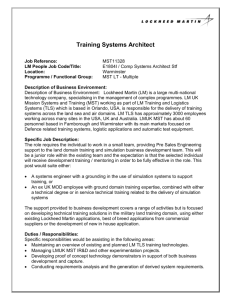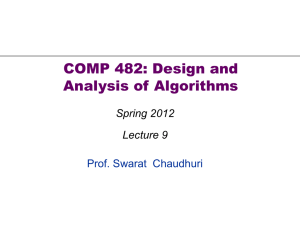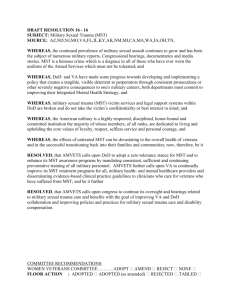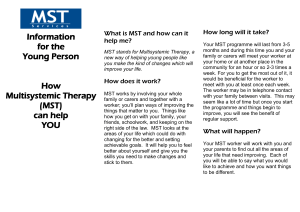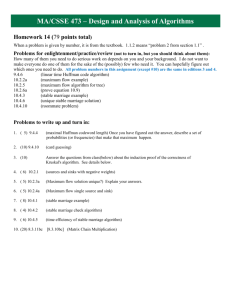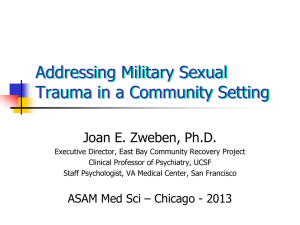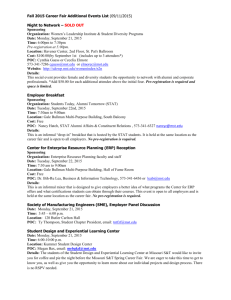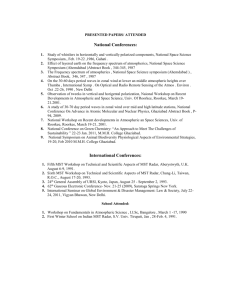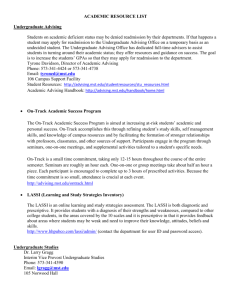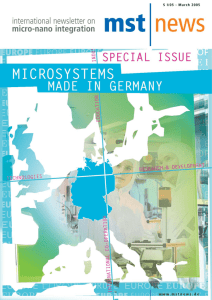Presentation 1
advertisement
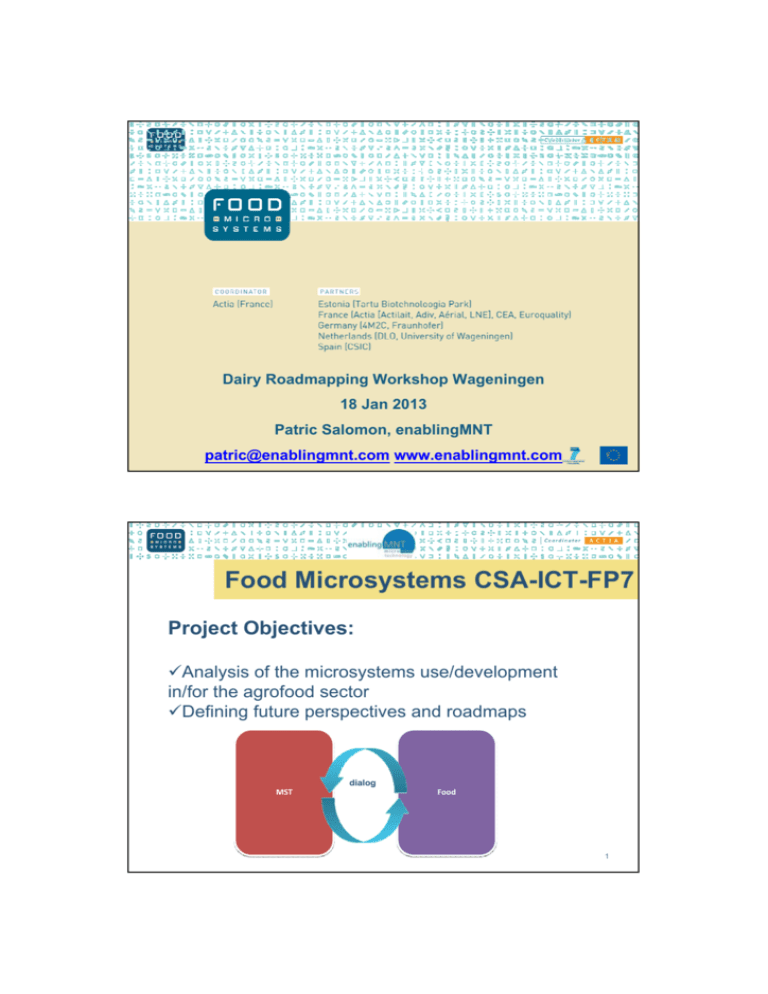
Dairy Roadmapping Workshop Wageningen 18 Jan 2013 Patric Salomon, enablingMNT patric@enablingmnt.com www.enablingmnt.com 1 Food Microsystems CSA-ICT-FP7 Project Objectives: 9Analysis of the microsystems use/development in/for the agrofood sector 9Defining future perspectives and roadmaps dialog MST Food 1 Food Industry challenges Quality and safety management Environ mental impact Agile & efficient production Quality Reduced environmental impact & Safety Food & beverage The food industry needs to guarantee food safety, improve process control and the quality of the food products, and decrease its impact on the environment (optimize raw material use and minimize waste) while continuing to provide affordable food supply to a growing population Efficient Productio n 3 Microsystems Innovations Biosensing System Integration MNT Smart Systems Phys-Chem sensing Continuous on line/ in line non-contact process control systems (e.g. micro-spectrometers, gas sensor systems). They may further derive into handheld devices for professionals or even for consumers (e.g. smartphone) Biosensing systems for in-situ punctual fast chemical and biological sensing. A combination of this and the previous approach may derive to smart tags-active packaging (energy and material issues to be solved) Autonomous physical-chemical wireless sensor networks for on-field environmental control 4 “MST for food” Environm. impact Biosensing Quality & Safety System Integration MST Smart Systems FMS Phys-Chem sensing Food & beverage Process control Miniaturised Physical –Chemical-Biological Systems for food/beverage processing, process control and environmental sustainability 5 Facts and figures of the food & beverage sector Food industry is a traditional and conservative industry mostly dealing with low margin/commodity products reluctant to take a proactive role in new technologies that have no fast ROI. It worries about reliability (or perception of such) of any new technology and it has a lack of MNT/MEMS/SSI awareness, Microsystems, MST, MEMS,...: What are they? µ/n-sensors Power devices (µ)power µ/n-actuatorsComunic sources ation Signal µ/n-structures processing & passives Characterization & Test Packaging & interconnect Micro/Nano-System Embedded software 7 Definition of MST for Food • The FMS area is microsystems (MST) with application in the food sector. • Microsystems are defined as systems that provide information on food products or change the properties of food products and involve component build with micro and nano technologies. It focuses on material / device / equipment developments that could be regarded as an ICT contribution to food applications. • We do not cover ingredients or additives in the food. 8 MST: From a chip… to an instrument Component or subsystem wafer on-line device portable benchtop Miniaturised and cost-effective instruments Main Microsystems areas of use • Food safety (pathogens, pesticides, mycotoxins, fungi, antibiotic contamination,…). • Food quality (freshness, ripeness, sugar content, taste, size, colour, odour…). • Logistics and traceability (transport, storage,…) • Food production control(improving efficiency, on-line, in-line control…) • …and development of novel functional and nutritional foods: Filtration / fractionation Emulsification / encapsulation Surface modification 10 and where MST can be used? Foodchain monitoring and traceability: safety and quality assessment stages Farmers Recollection Industrials Transport Processing (transforming, poisoning) Retailers Consumers Transport Storage Consumption (degrading) to eat, or not to eat. Storage (active-evolving, degrading) Safety and Quality Assessment with M&NT MST contribution: closeness to the foodstuff & power of analysis & speed (multisensing, multipoint sensing, continuous monitoring, automation/non-specialist intervention) FMS Survey: First commercial Products 12 European Research on MST for Food Technologies • Biosensors, Microfluidics and RFIDs are the more studied in Europe. • Also Flexible electronics and physical and chemical sensors. 13 Food Sectors in FP6 & FP7 MST R&D • Dairy and fruits, beverages and vegetables are the main food sectors, followed by meat 14 Applications in FP6 & FP7 R&D 15 Some conclusions from FMS study • Up to now, only logistics and traceability with RFID cards with integrated sensors is a potential mass market application. • Some products are already on the market but with a cost that is not yet low enough. • Other niche markets, especially for food safety and quality that are addressed with optical and bio-sensing solutions, but big commercial success has not yet been achieved. • Food process control, can help on assuring safety and quality but also on optimising the production. 16 Microstructures & microdevices & microsystems • Passive Microdevices (membranes, microsieves) • Physical sensors • Biosensors, DNA-chips • Chemical Sensors / e-noses, e-tongues / Microchromatographs 17 Microstructures & microdevices & microsystems • Optical Sensors / Microspectrometers • Microfluidics / Lab-on-a-chip • Printed electronics • RFIDs / Wireless Sensor Networks Ip-based Comm Air and earth temperature Air and earth humidity Wind direction Leafs parameters sothers Radio Comm 18 Some Conclusions of FMS survey • Looking for MST solutions that both can compete with laboratory systems but also that can complement them. • Current use of other non MST or standard laboratory solutions is still valid when small size is not a must • MST are looking for improving the stability and reliability of biosensors, as it is still an issue for on-line and in-line deployments • Regulations (samples of 25 g.) may be an issue for MNT based solutions, but they also create new regulations, and also be used for screening. 19 Summary: Applications/Sectors/Technologies 20 Relevant KBBE Calls – closing 5 Feb 2013 Area 2.2.3 Food processing KBBE.2013.2.3-01: Development and industrial application of sensors for food processing operations. Up to three projects may be funded • Collaborative Project (STREP, min 20% SMEs), max EUR 3M per proposal. Area 2.2.4 Food quality and safety KBBE.2013.2.4-01: Assuring quality and authenticity in the food chain. One project may be funded • Collaborative Project (IP), max EUR 9M per proposal. Area 2.2.5 Environmental impacts and total food chain KBBE.2013.2.5-01: Assessment of the impact of global drivers of change on Europe's food security. One project may be funded • Collaborative Project (STREP), max EUR 4M per proposal. KBBE.2013.2.5-02: Saving water and energy for resource-efficient food processing. Up to three projects may be funded • Collaborative Project (IP, min 20% SMEs), max EUR 6M per proposal. Area 2.2.6 European Research Area KBBE.2013.2.6-01: Exploitation of results of Framework Programme projects in food, health and wellbeing by small and medium-sized enterprises. Up to five projects may be funded • Collaborative Project (STREP, min 75% SMEs), max EUR 2M per proposal.
